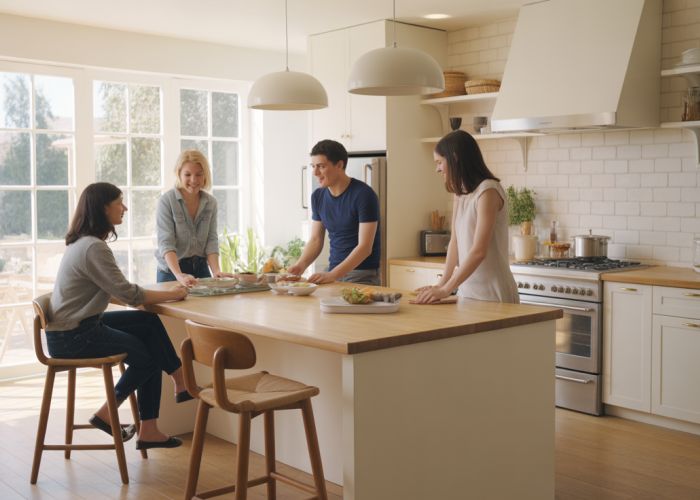The National Kitchen and Bath Association (NKBA) offers detailed guidelines for kitchen design, emphasizing optimal ergonomics. Consider the impact of countertop material choices like granite or quartz on the overall weight and support needed for your island. Bar stools designed for counter height may not be appropriate for a standard island, highlighting the importance of careful measurement. Determining the correct task lighting over your island hinges on knowing the exact surface area. All these factors play a crucial role in achieving the ideal standard island height to maximize both functionality and aesthetic appeal.

Finding Your Ideal Standard Island Height
Planning a kitchen island? Determining the "standard island height" is crucial for both comfort and functionality. This guide breaks down everything you need to know to make the right choice for your space.
Understanding the "Standard"
The term "standard island height" usually refers to the height of a kitchen island intended for primarily food preparation and casual dining using counter stools. It’s important to understand that this "standard" is more of a common guideline than a strict rule.
What is the typical standard island height?
The typical "standard" island height is 36 inches (91 centimeters). This height is designed to match standard kitchen countertop height and is generally suitable for comfortable chopping, mixing, and other food preparation tasks.
Why is 36 inches considered standard?
- Ergonomics: This height is generally comfortable for most adults to work at without straining their back or shoulders.
- Appliance compatibility: It matches the height of most dishwashers, ranges, and other kitchen appliances, creating a cohesive design.
- Counter Stools: 36-inch-high islands are designed for use with 24-inch counter stools, which are widely available.
Factors Affecting Your Ideal Island Height
While 36 inches is a good starting point, several factors can influence whether that’s the perfect height for your island.
User Height and Ergonomics
The most important factor is the height of the primary users of the kitchen.
- Taller Individuals: If you or other members of your household are significantly taller than average, you might consider raising the island height slightly, perhaps to 38 or even 40 inches.
- Shorter Individuals: Conversely, if users are shorter, a slightly lower island height, maybe closer to 34 inches, may be more comfortable.
To get a feel for what works best:
- Stand at your existing kitchen counter.
- Perform common tasks like chopping vegetables.
- Notice how your posture feels.
- If you find yourself hunching over or reaching up uncomfortably, that indicates a need to adjust the island height accordingly.
Island Functionality
Consider the primary function of your island.
- Food Preparation: 36 inches is generally ideal.
- Baking: Some bakers prefer a slightly lower surface for kneading dough. You could consider having a section of your island at a lower height, like 30 inches, dedicated to baking.
- Dining: If the island will be primarily used for dining, you might consider a raised bar-height section at 42 inches, which would require taller 30-inch bar stools. This creates visual separation and can be a stylish design choice.
Counter Stool Height
The height of your counter stools is directly related to the island height. A comfortable seating arrangement typically requires about 12 inches of space between the seat and the underside of the island countertop.
- 36-inch Island: Requires 24-inch counter stools.
- 42-inch Island (Bar Height): Requires 30-inch bar stools.
Multi-Level Islands
Multi-level islands offer flexibility and visual interest. A common design includes a 36-inch main countertop with a raised bar-height section (42 inches). This allows for both comfortable food preparation and casual dining or socializing.
Measuring for Success
Accurate measurements are essential for ensuring a comfortable and functional island height.
- Measure existing countertops: Determine the height of your existing kitchen countertops. This provides a baseline for your island height.
- Consider under-counter appliances: If you plan to incorporate appliances like dishwashers or wine coolers, factor in their height when determining the final island height.
- Plan for overhangs: If you plan to include an overhang for seating, make sure you have adequate knee space. Generally, aim for a minimum of 12 inches of overhang depth.
- Double-check everything: Before finalizing your plans, double-check all measurements to ensure accuracy and prevent costly mistakes.
Island Height Examples
Here’s a table summarizing typical island heights and their corresponding counter stool heights:
| Island Height (Inches) | Stool Height (Inches) | Common Use Case |
|---|---|---|
| 30 | 18 | Lower prep area (baking) |
| 36 | 24 | Standard counter height, food prep, dining |
| 42 | 30 | Bar height, casual dining, socializing |
FAQs: Standard Island Height
Here are some common questions about kitchen island height to help you find the perfect fit.
What is the typical height for a kitchen island?
The standard island height is typically 36 inches. This height matches standard kitchen countertops, creating a seamless look and comfortable workspace for most people.
Why is 36 inches considered the "standard island height"?
36 inches became the standard island height because it aligns with standard base cabinets. This height is comfortable for chopping, prepping, and other kitchen tasks for average-height adults.
Can I have a different island height?
Yes! While 36 inches is the standard, you can customize your island height. Consider 42 inches for a bar-height island, perfect for stools. You might also want a lower section for baking or other specific uses.
Does island height affect seating choices?
Absolutely. Standard island height (36 inches) typically requires counter-height stools. If you opt for a 42-inch island, you’ll need bar-height stools. Carefully consider seating height when planning your island design.
So, there you have it! Figuring out the perfect standard island height doesn’t have to be a headache. We hope this cleared things up and gets you one step closer to your dream kitchen!